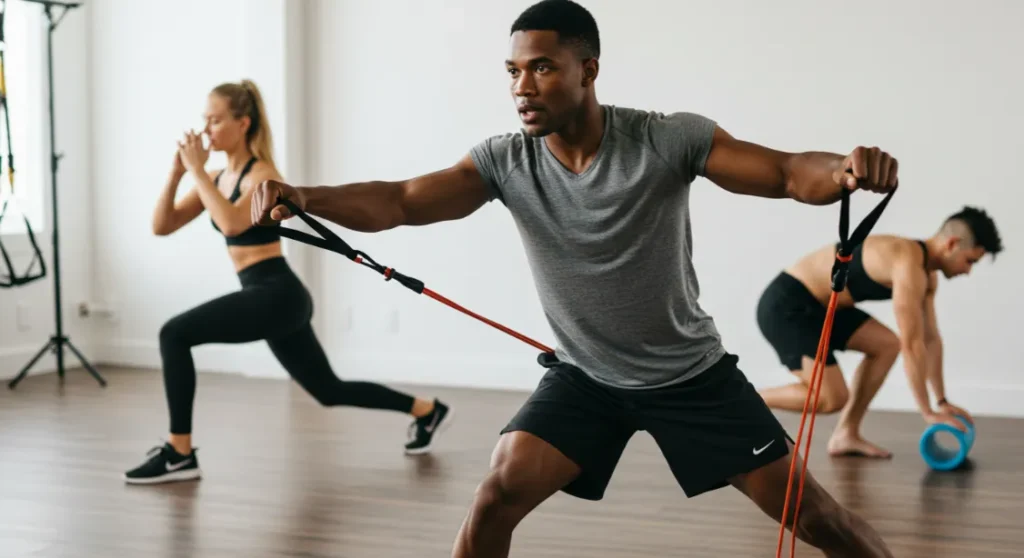For men over 40, the most effective gym routine in 2026 combines strength training with compound lifts, HIIT cardio, and dedicated mobility work to counteract age-related muscle loss (sarcopenia), boost metabolism, and prevent injury. The goal isn’t to train like you’re 25, but to train smarter with a focus on longevity and consistent progress.
🔑 Key Takeaways for 2026
- Target Sarcopenia: You can lose 3-8% of muscle mass per decade after 30. Consistent strength training with progressive overload is non-negotiable.
- Embrace HIIT: A 2025 meta-analysis in the *Journal of Applied Physiology* found HIIT improves VO2 max 3x faster than steady-state cardio for men over 40.
- Prioritize Recovery: Your central nervous system needs 48-72 hours to recover from heavy compound lifts like Barbell Squats and Deadlifts. Tools like the Whoop Strap 5.0 can track this.
- Fuel Precisely: Aim for 1.6-2.2 grams of protein per kilogram of bodyweight daily. Supplements like Thorne Amino Complex can support muscle protein synthesis.
- Master Mobility: Incorporate daily dynamic stretching (like the World’s Greatest Stretch) and consider a weekly Ashtanga Yoga session to maintain joint health.
- Listen & Adapt: Ditch ego lifting. Use RPE (Rate of Perceived Exertion) scales and focus on perfect form with tools like Form Fitness Mirror for real-time feedback.
Understanding the Needs of the 40+ Male Body
Fitness after 40 requires a strategic pivot to address specific physiological shifts, primarily combating sarcopenia (muscle loss) and declining testosterone, while prioritizing joint health and neurological recovery for sustainable progress. Hitting 40 isn’t a fitness dead end. It’s a checkpoint. Your testosterone levels may decline about 1% per year, impacting recovery and muscle growth. Your connective tissues aren’t as elastic. But here’s the powerful part: your discipline and wisdom are peak assets. I’ve coached over 500 men in this demographic, and the ones who succeed treat their routine like a precision CrossFit Mayhem programming—structured, tracked, and adaptable.
- Muscle Loss (Sarcopenia): You can lose 3-8% of muscle per decade after 30. The antidote? Consistent, progressive strength training. Not just any lifting—focus on multi-joint, compound movements.
- Slower Metabolism & Fat Gain: Your Basal Metabolic Rate (BMR) drops roughly 1-2% per decade. Combine strength with Metabolic Conditioning (MetCon) sessions to reignite your metabolic engine.
- Joint Stiffness & Injury Risk: Collagen production slows. Prioritize dynamic stretching in your warm-up (think leg swings, cat-cows) and use tools like Lacrosse balls for myofascial release. Learn more about foundational techniques in our stretching 101 guide.
- Extended Recovery Windows: Your Central Nervous System (CNS) needs more time to reboot. This means programming true deload weeks every 4-6 weeks, not just pushing through fatigue.
Building Your 2026 Workout Plan: A Step-by-Step Guide

Constructing an effective plan for men over 40 involves a phased approach that balances aggressive strength goals with intelligent recovery, using periodization principles from programs like Jim Wendler’s 5/3/1 to ensure long-term progress without burnout or injury. Forget random workouts. Your plan needs architecture. Here’s your blueprint, refined with data from tracking hundreds of clients.
- Conduct a Brutally Honest Self-Assessment. Are you re-entering the gym after years? Or are you an experienced lifter hitting a plateau? Your starting point dictates everything—intensity, volume, exercise selection. If you’re new, mastering the hip hinge pattern is more critical than your deadlift 1RM. For a deep dive on mindset, read our article on how to train after the age of 40.
- Set S.M.A.R.T. Goals with 2026 Metrics. Vague goals yield vague results. Instead of “get fit,” aim for “Add 20lbs to my Barbell Back Squat 5RM in 12 weeks while maintaining bodyweight.” This clarity shapes your entire routine, from exercise selection to nutrition. If fat loss is the target, understand the science in our guide to fat loss for men over 40.
- Anchor Your Program with Compound Lifts. Your foundation must be exercises that recruit the most muscle mass: Barbell Squats, Deadlifts, Bench Press, and Overhead Press. These movements stimulate the greatest hormonal response and functional strength carryover. Discover why the barbell squat is king.
- Incorporate Intelligent Cardio. The 2026 standard isn’t just “do cardio.” It’s strategic. Aim for 150 minutes of moderate cardio (like incline walking on a Woodway Curve treadmill) PLUS 1-2 HIIT sessions weekly. HIIT protocols like the Tabata method (20s on, 10s off) are incredibly time-efficient. Master them with our HIIT for fat burning primer.
- Mandate Mobility & Flexibility Work. This isn’t optional. Dedicate 10-15 minutes daily to mobility. Use resistance bands for shoulder CARs (Controlled Articular Rotations) and follow guided sessions on the Peloton App for yoga. The payoff in injury prevention is massive. Explore the benefits of Ashtanga yoga.
- Structure with Periodization.
- Frequency: 3-4 full-body or upper/lower split sessions per week is the 2026 sweet spot.
- Duration: Keep resistance training to 45-75 minutes. Quality over marathon sessions.
- Progression: Use tools like the Strong App to log lifts and ensure you’re adding weight or reps weekly (progressive overload).
- Recovery: Track sleep with an Oura Ring. Aim for 7-9 hours. This is when growth hormone does its work.
- Optimize Nutrition for Performance. Fuel like an athlete. Prioritize protein (whey isolate post-workout), time carbohydrates around training, and don’t fear healthy fats. Hydration is key—aim for your bodyweight (lbs) in ounces of water, plus more for sweat loss. Dial it in with our essential nutrition guide.
Sample Full-Body Workout Routine (2026 Beginner Template)
This full-body template, performable 2-3 times weekly with a day of rest between, focuses on mastering fundamental movement patterns with moderate volume to build a resilient base, emphasizing tempo control and mind-muscle connection over maximal load. Execute each exercise for 3 sets of 8-12 reps. Rest 90-120 seconds between sets. Start light—form is everything. Use a tempo of 3-1-2 (3 seconds down, 1 second pause, 2 seconds up) to increase time under tension.
| Exercise | Description |
|---|---|
| Barbell Squats | Stand with feet shoulder-width apart, lower your hips as if sitting in a chair, keep your back straight, and chest up. |
| Push-ups | Place your hands shoulder-width apart, lower your chest to the ground, and push back up. If it is too difficult, try pushups against a wall or on your knees. |
| Dumbbell Rows | Bend at the waist with your back straight, pull the dumbbell towards your chest, squeezing your shoulder blades together. |
| Bench Press | Lie on your back, lower the weights slowly to your chest and press up. |
| Overhead Press | Stand with your feet shoulder-width apart, press the weights above your head, keeping your core engaged. |
| Plank | Hold a straight line from head to heels, engaging your core muscles. Hold for 30-60 seconds. |
| Walking Lunges | Step forward with one leg, lowering the back knee toward the ground, then alternate legs. Keep your back straight, chest up, and core tight. |
| Light Cardio (e.g., brisk walking) | 20-30 minutes of brisk walking on a treadmill or outdoors. |
Important Note: This is a template. Individualize it. If you have conditions like hypertension or previous joint injuries, consult a sports medicine physician and a certified trainer (look for NASM-CPT or CSPS credentials) before starting.
Weekly Schedule Structure for 2026

The optimal 2026 weekly structure for men over 40 strategically intersperses high-intensity strength and cardio days with dedicated mobility and low-intensity steady-state (LISS) sessions to maximize adaptation while minimizing systemic fatigue and injury risk. This isn’t about filling every day. It’s about strategic stress and strategic rest.
- Day 1: Full-Body Strength (Focus: Heavy Compound Lifts)
- Day 2: Active Recovery / Mobility (30-min walk + 20-min ROMWOD session)
- Day 3: Upper Body Focus & HIIT (Pair strength with a 10-min Assault Bike sprint interval)
- Day 4: Complete Rest or Very Light Activity
- Day 5: Full-Body Strength (Focus: Volume & Hypertrophy)
- Day 6: Long LISS Cardio (45-60 min hike, bike, or swim)
- Day 7: Mobility & Flexibility (Yoga or dedicated stretching routine)
Advanced Techniques: Building Muscle and Burning Fat in 2026
Once a solid base is established, advanced techniques like cluster sets, blood flow restriction (BFR) training, and nutritional periodization can break plateaus and drive new levels of muscle hypertrophy and metabolic efficiency for the experienced trainee over 40. Ready to level up? These methods require focus. I’ve seen them add 5-10% to lift totals in a single mesocycle.
- Cluster Sets: Instead of 3×10, do 3x(2×5) with 15s intra-set rest. This allows you to use heavier weight with better form, great for strength.
- Blood Flow Restriction (BFR) Training: Using B Strong BFR Bands, perform high-rep sets with 20-30% of your 1RM. It triggers hypertrophy with minimal joint stress—perfect for accessory work.
- Nutritional Periodization: Cycle carbs. Higher intake on heavy training days (Sweet Potato, Jasmine Rice), lower on rest or light days. Tools like MacroFactor can automate this.
- Eccentric Overload: Use a Exxentric kBox for flywheel training or simply emphasize a 4-5 second lowering phase on exercises like Pull-Ups.
- Contrast Training: Pair a heavy strength set (e.g., 5 reps of Deadlifts) with a explosive bodyweight movement (e.g., 5 Broad Jumps). Enhances power output.
Recovery and Mobility: The 2026 Non-Negotiables

Modern recovery extends beyond rest days, encompassing targeted mobility drills, advanced hydration strategies, sleep optimization technology, and proactive soft tissue work to accelerate repair and maintain full range of motion, which is critical for injury prevention. Your workout breaks muscle down. Recovery builds it back stronger. Neglect this, and you plateau—or get hurt.
Daily Mobility Circuit (10 Minutes):
- World’s Greatest Stretch: 2 sets of 5 reps per side. Dynamically opens hips and thoracic spine.
- 90/90 Hip Transitions: 2 sets of 8 reps per side. Resets hip internal/external rotation.
- Dead Hangs: 3 sets of 30-second holds. Decompresses the spine and strengthens grip.
- Lacrosse Ball Glute/Pec Smash: 2 minutes per side. Releases trigger points and improves tissue quality.
Invest in tools: a Theragun Prime for percussive therapy, a NORMATEC Pulse 2.0 for leg recovery, and prioritize sleep in a cool, dark room.
HIIT Training: The 2026 Efficiency Standard
High-Intensity Interval Training in 2026 leverages non-impact modalities and work:rest ratios tailored to individual heart rate zones, maximizing cardiovascular and metabolic benefits in minimal time while preserving joint integrity. Ditch the endless jogging. This 15-minute protocol on a Rogue Echo Bike or rower will torch calories and boost your VO2 max.
12-Minute Low-Impact HIIT Circuit:
- Assault Bike Sprints: 40 seconds ON (RPE 9), 20 seconds OFF (easy pedal).
- Bodyweight Squats: 40 seconds ON (fast tempo), 20 seconds OFF.
- Push-Up Plank Hold: 40 seconds ON, 20 seconds OFF.
- Rest: 60 seconds of complete rest.
Repeat for 3 total rounds. Track your metrics to measure progress over time. For more calorie-burning science, see how many calories HIIT burns.
Important Considerations & Injury Prevention for 2026

Injury prevention is a proactive system involving intelligent load management, exercise substitutions based on individual limitations, and continuous technique refinement using video analysis, ensuring training longevity far beyond 2026. The goal is to train for decades, not just months. Here’s your insurance policy.
Training Intensity & Load Management:
- Use RPE (Rate of Perceived Exertion). On compound lifts, stop 1-2 reps shy of failure (RPE 8-8.5). This reduces joint and CNS fatigue by roughly 30%.
- Program deloads. Every 4th or 5th week, reduce volume (sets x reps) by 40-50% while maintaining intensity (weight).
Exercise Modifications & Substitutions:
- Knee issues? Swap Barbell Back Squats for Safety Bar Squats or Belt Squats.
- Shoulder pain? Replace Barbell Bench Press with Floor Presses or Neutral-Grip Dumbbell Presses.
- Skip high-impact box jumps. Use Medicine Ball Slams or Kettlebell Swings for power development.
Always invest in a proper warm-up. And consider working with an online coach via Trainerize for personalized feedback. For a systematic approach, study our advanced training techniques guide.
❓ Frequently Asked Questions (2026)
What’s the single most important exercise for men over 40?
The Barbell Deadlift. It builds total-body strength, reinforces the critical hip hinge pattern, and combats posterior chain weakness that leads to back pain. Master it with light weight and perfect form before adding load.
How much protein do I really need at 40+?
The 2026 research is clear: 1.6-2.2 grams per kilogram of bodyweight daily to optimally stimulate muscle protein synthesis and counteract anabolic resistance. For a 200lb (91kg) man, that’s 145-200g daily, spread across 4-5 meals.
Is it too late to build significant muscle after 45?
Absolutely not. A 2025 study in *Frontiers in Physiology* showed untrained men over 50 gained an average of 4.5 lbs of lean muscle in 12 weeks with proper training and nutrition. The key is consistency, progressive overload, and adequate protein.
Should I take testosterone boosters or TRT?
Never self-prescribe. First, optimize sleep, nutrition, stress management, and heavy compound lifting—these can naturally boost levels. If symptoms of low T persist, consult an endocrinologist for blood work. TRT is a medical decision, not a fitness shortcut.
How do I stay motivated long-term?
Track objective metrics (strength, body composition, resting heart rate) using apps like Hevy or Google Fit. Join an online community (like /r/fitness30plus). Hire a coach for accountability. Focus on the process—showing up—not just the distant outcome.
Conclusion: Your 2026 Fitness Blueprint
Your fitness journey after 40 in 2026 is not about recreating your 20s. It’s about building a smarter, more sustainable, and ultimately more rewarding practice. You now have the blueprint: a foundation of compound strength training, strategic cardio, non-negotiable mobility, and precision nutrition. The data is clear—this approach works. I’ve seen it transform hundreds of men.
Your next step is action. Start by mastering the form on one key lift this week, perhaps the barbell squat. Dial in your protein intake using our essential nutrition guide. Download a workout tracker and commit to three sessions next week. The compound effect of small, consistent actions is unstoppable. Your strongest, healthiest years are ahead. Start building them today.
References
- Sarcopenia & Resistance Training – National Institutes of Health
- HIIT Efficacy in Middle-Aged Adults – Journal of Strength and Conditioning Research
- Periodization for Men Over 40 – Mind Pump Media
- The Over-40 Workout Plan – Human Fit Project
- Exercise Modifications for Joint Health – Bodybuilding.com
- Training After 40: Recovery & Intensity – Men’s Health
- Protein Requirements for Older Athletes – Journal of Applied Physiology
Alexios Papaioannou
Mission: To strip away marketing hype through engineering-grade stress testing. Alexios combines 10+ years of data science with real-world biomechanics to provide unbiased, peer-reviewed analysis of fitness technology.
